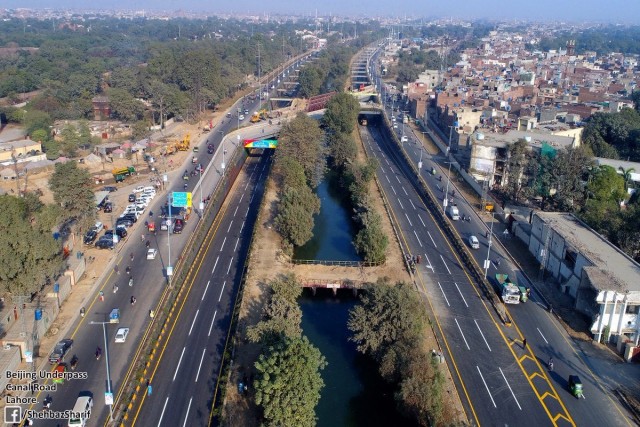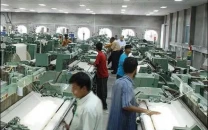Resource generation: Provinces must concentrate on raising their own revenues
Punjab fears slowdown in the flow of resources from the Centre

Image of Beijing Underpass in Punjab. PHOTO: GOVT OF PUNJAB TWITTER @GovtOfPunjab
The province has recently launched the Punjab Population Innovation Fund (PPIF) that is working to identify, implement and scale up innovative ideas to tinker with factors that will control population growth.
However, given the current apparatus of sharing resources and political strength between provinces, a higher population goes in favour of the province. The main tool to split resources between the provinces is the National Finance Commission (NFC) Award.
The NFC Award is the distribution of financial resources among the provinces by the federal government on an annual basis. Taxes are pooled at the federal level and then distributed among provinces.
End existing protocol: Sindh seeks quick transfer of funds
However, there exist disagreements between practitioners, politicians, academics and policymakers on which taxes should form part of this pooled resource. At present, taxes that contribute to the pool include income tax, general sales tax, wealth tax, capital gains tax and customs duty. Most tax receipts come from Punjab and Sindh provinces.
History of NFC Awards
The first NFC Award was given in 1974 by the elected government of late ZA Bhutto. This award set population as the only criterion for revenue distribution among the provinces. Customs duty, the main revenue earner, was kept out of the divisible pool and sales tax was completely federalised.
The second NFC Award was given in 1991 by the government of PML-N headed by Nawaz Sharif. This award recognised for the first time the rights of provinces over natural resources and the provinces were given royalty and gas development surcharge on oil and gas.
The third NFC Award was declared in February 1997 by the caretaker government of Farooq Ahmed Khan Leghari and Prime Minister Malik Meraj Khalid. Population remained the sole criterion for resource distribution, which is not the best practice around the world.
The last NFC Award came into force in July 2010 after the 18th Constitutional Amendment. It not only enlarged the divisible pool of taxes (through a reduction in collection charges from an average of 5.2% to 1%), but also enhanced the provincial share in the divisible pool (from 46.25% to 56% in the first year of the NFC Award and 57.5% in subsequent years). It significantly boosted the trend of fiscal decentralisation in Pakistan.
Furthermore, it introduced multiple criteria for horizontal transfers, replacing the traditional population-based criteria.
According to the revised criteria, 82% distribution was linked with population, 10.3% with poverty and backwardness, 5% with revenue collection and 2.7% with inverse population density.
Consequently, Punjab got 51.74% from the divisible pool, Sindh 24.5%, Khyber-Pakhtunkhwa (K-P) 14.62% and Balochistan 9.09%. In addition, K-P received 1% from the total divisible pool for expenses incurred by the province in the war on terror during the award period.
Punjab’s performance and trade-off
As per the latest population census, Punjab’s population growth rate of 2.13% has been lower than the national average of 2.4%. This implies that Punjab is growing slower relative to other provinces. The most growth has been in K-P. This slower growth rate is having two impacts on Punjab.
Seats in the National Assembly are allocated to the four provinces based on population. Punjab, being the most populous province, gets more than half the seats in the assembly, however, if the trends seen in the 2017 census continue, Punjab will lose seats to other provinces, reducing its political clout.
Moreover, as the NFC Award is still heavily reliant on population (82% weight), losing the weightage will result in a reduction in the financial share of Punjab in the divisible pool. Thus, Punjab’s relative success in controlling population growth may come back to haunt it in the shape of both reduced financial share and political space in the National Assembly.
The way forward
The trade-off explained above raises questions for the policymakers in Punjab. Controlling population is one of the key priorities of the government as it leads to multiple issues of governance and inadequate delivery of services, putting a higher burden on the government.
Flipping the coin, reduced population implies lesser resources flowing from the federation to the province. One way to address this issue is to advocate for an NFC formula that reduces the weight of population and include more performance-related indicators to determine the shares.
This, however, can only be partly helpful as the government acting as a benevolent dictator should provide for all and hence the weight of population in the division formula will remain significant.
A more sustainable and effective solution for Punjab and other provinces is to concentrate on raising their ‘own source’ revenues. Opportunities of these are immense in Punjab. A recent success has been the establishment of the Punjab Revenue Authority (PRA).
PRA with the technical assistance of experts last year conducted a survey in which they identified around 25,000 new taxpayers and mapped categories of taxable services. This is a remarkable achievement as getting tax surveys done in the country have not had much success in the history.
PRA must work towards rationalising its strategy and enhancing the tax base rather than to just concentrate on few big cash cows.
Additionally, Punjab has worked with great zeal to strengthen its Finance Department, with new units/wings such as corporate finance, tax reforms, debt management and risk management being operationalised over the last year.
Sindh protests over its gas consumption by Punjab
Finally, Punjab should seek innovative solutions such as mobile banking to automate most of the provincial collections such as property taxes, licence fee and other similar collections. Hence, if dealt with an appropriate response, one can say that the trade-off is not really real.
Dr M Amanullah is the chief economist and Muhammad Usman Khan is the adviser at the Planning and Development Department, Punjab
Published in The Express Tribune, December 18th, 2017.
Like Business on Facebook, follow @TribuneBiz on Twitter to stay informed and join in the conversation.



1728020501-0/Express-Tribune-Web-(13)1728020501-0-208x130.webp)







1726134115-0/BeFunk_-(41)1726134115-0-208x130.webp)







COMMENTS
Comments are moderated and generally will be posted if they are on-topic and not abusive.
For more information, please see our Comments FAQ